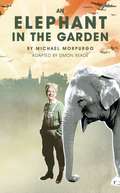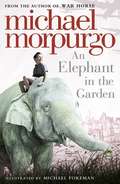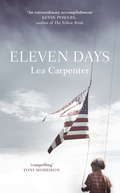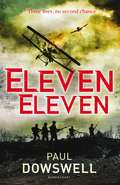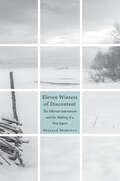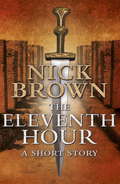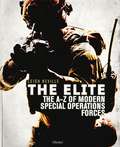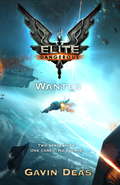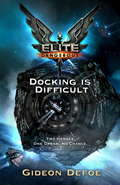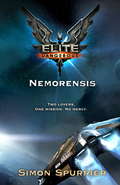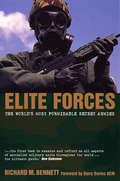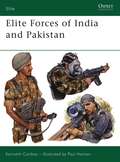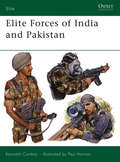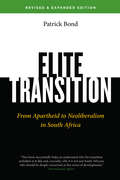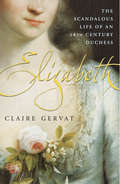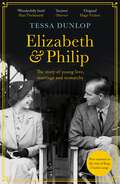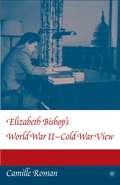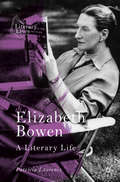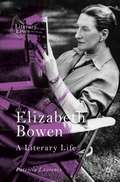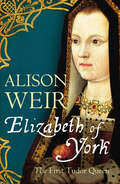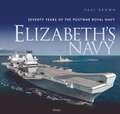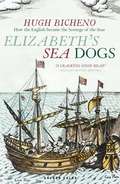- Table View
- List View
An Elephant in the Garden (Oberon Modern Plays)
by Michael Morpurgo Simon Reade1945. Dresden, Germany. Lizzie, her mother – and an elephant from the zoo, flee the Allied fire-bombing in the end-game of the Second World War. Escaping the Allies’ advance from the West – and also the advancing Russian armies from the East – this extraordinary trio of refugees meet: a downed RAF officer, cowering in a barn; a homeless school choir on the run and their Countess saviour, harbouring them from the Nazis; and the mechanised American cavalry, appearing over the horizon. It is Lizzie’s story – but Marlene, the elephant, is the heroine. Plodding, obdurate, opportunistic, load-bearing, indestructible, cheering – Marlene embodies the stubbornness of the human will and how it will do everything to survive.
An Elephant In The Garden (PDF)
by Michael MorpurgoA thrilling and moving novel about an extraordinary animal caught up in a very human war, for anyone who loved The Amazing Story of Adolphus Tips or The Butterfly Lionâe¦ By the award-winning former Childrenâe(tm)s Laureate and author of War Horse. Dresden, 1945. Elizabeth and Karli's mother works at the zoo, where her favourite animal is a young elephant named Marlene. Then the zoo director tells her that the dangerous animals âe" including the elephants âe" must be shot before the town is bombed. Unable to give Marlene up, their mother moves her into the back garden to save herâe¦ and then the bombs start to fall. Their home destroyed, the whole family must flee the bombed-out city and through the perilous, snow-covered landscape, all the while avoiding the Russian troops who are drawing ever closer. It would be hard enough to do, without an elephant in towâe¦
Eleven Days (Vintage Contemporaries Ser.)
by Lea CarpenterLONGLISTED FOR THE BAILEYS WOMEN'S PRIZE FOR FICTION 2014'SUPERB' - SIMON SEBAG MONTEFIORE, LONDON EVENING STANDARD BOOKS OF THE YEAR 2013'EXTRAORDINARY' - KEVIN POWERS, AUTHOR OF THE YELLOW BIRDS'THINK HOMELAND IN FICTION FORM...' - RED'AN EXTRAORDINARILY GIFTED WRITER' - MICHIKO KAKUTANI, NEW YORK TIMESEleven Days is, at its heart, the story of a mother and a son.It begins in May 2011: Sara's son Jason has been missing for nine days in the aftermath of a special operations forces mission. Out of devotion to him, Sara has made herself knowledgeable about things military, but she knows nothing more about her son's disappearance than the press corps camped out in her driveway. In a series of flashbacks we learn about Jason's absentee father - a man who died, according to "insiders," helping to make the country safer - and Jason's decision to join the U.S. Naval Academy at Annapolis after 9/11 and enter into the toughest military training in the world: for the U.S. Naval Special Warfare's Navy SEAL Teams. Through letters Jason wrote his mother while training, we see him becoming a strong, compassionate leader. But his fate will be determined by events that fall outside the sphere of his training, and far outside the strong embrace of his mother's love. As well as a touching picture of the bond between a mother and a son this is a unique look into the training, history and culture of one of the world's elite forces. Page-turning and haunting, this is an astonishing debut which questions the very nature of sacrifice and love.
Eleven Eleven
by Paul DowswellSet during the final 24 hours before the armistice at 11 a.m. on 11th November 1918, the story follows a German storm trooper, an American airman and a British Tommy. Their destinies converge during the death throes of the first ever conflict to spread across the globe. War becomes incredibly personal as nationality and geography cease to matter to each of these teenagers on the Western Front, and friendship becomes the defining aspect of their encounter. But who will live and who will die before the end of the day?
Eleven Winters of Discontent: The Siberian Internment and the Making of a New Japan
by Sherzod MuminovThe odyssey of 600,000 imperial Japanese soldiers incarcerated in Soviet labor camps after World War II and their fraught repatriation to postwar Japan. In August 1945 the Soviet Union seized the Japanese puppet state of Manchukuo and the colony of Southern Sakhalin, capturing more than 600,000 Japanese soldiers, who were transported to labor camps across the Soviet Union but primarily concentrated in Siberia and the Far East. Imprisonment came as a surprise to the soldiers, who thought they were being shipped home. The Japanese prisoners became a workforce for the rebuilding Soviets, as well as pawns in the Cold War. Alongside other Axis POWs, they did backbreaking jobs, from mining and logging to agriculture and construction. They were routinely subjected to “reeducation” glorifying the Soviet system and urging them to support the newly legalized Japanese Communist Party and to resist American influence in Japan upon repatriation. About 60,000 Japanese didn’t survive Siberia. The rest were sent home in waves, the last lingering in the camps until 1956. Already laid low by war and years of hard labor, returnees faced the final shock and alienation of an unrecognizable homeland, transformed after the demise of the imperial state. Sherzod Muminov draws on extensive Japanese, Russian, and English archives—including memoirs and survivor interviews—to piece together a portrait of life in Siberia and in Japan afterward. Eleven Winters of Discontent reveals the real people underneath facile tropes of the prisoner of war and expands our understanding of the Cold War front. Superpower confrontation played out in the Siberian camps as surely as it did in Berlin or the Bay of Pigs.
The Eleventh Hour
by Nick BrownSyria, 262 AD. Imperial agent Abascantius has failed his superiors and now faces the unwelcome prospect of a return to the legions. With only hours to work with, he will need resourcefulness and ruthlessness in equal measure if he is to salvage the situation and save himself. From Agent of Rome author Nick Brown, this compelling short story is set in the violent, corrupt underbelly of third century Antioch.
The Elite: The A–Z of Modern Special Operations Forces (Elite Ser. #211)
by Leigh NevilleUsing previously unpublished images from around the world, as well as maps and illustrations, The Elite: The A-Z of Modern Special Operations Forces is the ultimate guide to the secretive world of modern Special Forces. It sends the reader back in time to operations such as Eagle Claw in Iran and the recapture of the Iranian Embassy in London and then forward to recent operations against al Shabaab and Islamic State. Entries also detail units ranging from the New Zealand SAS Group to the Polish GROM, and key individuals from Iraq counter-terrorism strategist General Stanley McChrystal to Victoria Cross recipient SASR Corporal Mark Donaldson. Answering questions such as how much the latest four-tube night vision goggles worn by the SEALs in Zero Dark Thirty cost, what types of parachutes are used to covertly parachute into a target location, and if Special Forces still use HALO jumps, this book is the definitive single-source guide to the world's elite Special Forces.
The Elite: The A–Z of Modern Special Operations Forces
by Leigh NevilleUsing previously unpublished images from around the world, as well as maps and illustrations, The Elite: The A-Z of Modern Special Operations Forces is the ultimate guide to the secretive world of modern Special Forces. It sends the reader back in time to operations such as Eagle Claw in Iran and the recapture of the Iranian Embassy in London and then forward to recent operations against al Shabaab and Islamic State. Entries also detail units ranging from the New Zealand SAS Group to the Polish GROM, and key individuals from Iraq counter-terrorism strategist General Stanley McChrystal to Victoria Cross recipient SASR Corporal Mark Donaldson. Answering questions such as how much the latest four-tube night vision goggles worn by the SEALs in Zero Dark Thirty cost, what types of parachutes are used to covertly parachute into a target location, and if Special Forces still use HALO jumps, this book is the definitive single-source guide to the world's elite Special Forces.
Elite Dangerous: Two Spaceships, One Cargo, No Escape (Elite: Dangerous)
by Gavin DeasSet in the world of bestselling computer game ELITE, and launched to tie in with the latest version, ELITE: DANGEROUS - a game almost 20 years in the making. One of three very distinct - but subtly linked - novels written by major authors who are fans of the game, this novel will be a must-buy not only for the 25,000+ people who funded the new game on kickstarter, but also for all of those fans of the original game.When a routine bit of piracy goes wrong, the crew of the Song of Stone realise that there's a bounty hunter on their tail. One who might, finally, be able to outclass them. The Dragon Queen is feared across space, and for good reason. But even the bounty hunter doesn't realise what she's been hired to do. Or what is in the container she's been sent to retrieve.And she's not the only hunter in the game...Gavin Deas is the pseudonym used by Stephen Deas and Gavin Smith when writing together.
Elite Dangerous: Docking is Difficult (Elite: Dangerous)
by Gideon DefoeSet in the world of bestselling computer game ELITE, and launched to tie in with the latest version, ELITE: DANGEROUS - a game almost 20 years in the making. One of three very distinct - but subtly linked - novels written by major authors who are fans of the game, this novel will be a must-buy not only the 25,000+ people who funded the new game on kickstarter, but also for all of those fans of the original game.On what might be the worst planet in the universe, a young man dreams of the stars. Adventure! Lasers! Women! And the ultimate goal - to become Elite!Unfortunately, Misha has to do his chores first. And learn how to talk to Phoebe, the beautiful customs officer. And leave the planet.But the death of a famous author unexpectedly drags Misha and Phoebe into a system-wide conspiracy, complete with smuggling, international art thieves, multi-system corporations, canapés and exploding pigs. This is Misha's chance to prove he has what it takes!After all, surely anyone can be Elite if they dream...
Elite Dangerous: Nemorensis (Elite: Dangerous)
by Simon SpurrierSet in the world of bestselling computer game ELITE, and launched to tie in with the latest version, ELITE: DANGEROUS - a game almost 20 years in the making. One of three very distinct - but subtly linked - novels written by major authors who are fans of the game, this novel will be a must-buy not only the 25,000+ people who funded the new game on kickstarter, but also for all of those fans of the original game.Two lovers steal a spaceship and go on the run, attacking at random and revelling in the fame and glory their violence brings them. Celebrated by the jaded youth of the Federation and urged on to ever more flashy acts of destruction, they know it won't be long before they are caught and killed.But someone is following the couple. Someone who knows why they are so obsessed with each other. Who knows where they are heading. Who knows why.Someone who knows more about them than they do themselves. And has another plan for their deaths...
Elite Forces: The World's Most Formidable Secret Armies
by R M BennettThe invincible reputation of specialist military units such as the USA's Delta Force, Israel's IDP, and of course, Britian's SAS has grown steadily in recent years. Thanks to a number of successful campaigns and anti-terror operations, from London's Iranian Embassy siege in 1980 to the second Gulf War, in which they played a crucial role, it's now assumed that special forces are ideal for our world of small, localised conflicts - and especially George W Bush's war on terror.Elite Forces: The World's Most Formidable Secret Armies:- Contains over 500 compelling entries that cut through myth and secrecy.- Details the history, selection and training procedures and orders of battle of every major elite fighting force in the world today.- Is packed with hair-raising examples of individual heroism, endurance and courage in adversity.- Is fully up to date and includes recent coalition operations in Afghanistan and Iraq.- Takes an objective look at what happens when things go wrong, as they did most famously during the Gulf War of 1991 and in America's intervention in Somalia in 1993.- Explores the hidden links between elite forces and governments, intelligence organisations and business, and their controversial lack of accountability.- Examines how new technologies have come to the aid of the elite soldier.This is the first book of its kind to examine all aspects of the overlap between elite forces and the hidden worlds of intelligence and counter-terrorism, and takes an objective look at the secret, controversial role of special forces and 'Freelancers' in covert, deadly operations around the world. Elite Forces is a compelling, revealing - and occasionally shocking - read, and an authoritive and easy-to-use reference resource.
Elite Forces of India and Pakistan (Elite)
by Kenneth Conboy Paul HannonInfluenced by the German use of paratroopers early in World War Two, General Sir Robert Cassels, the Commander-in-Chief India, ordered the formation of an airborne cadre in October 1940. Thus marked the origins of India's first élite units. Pakistan can trace the origins of its own army airborne to the common parentage of British-raised forces. Following the partition from India in August 1947, it raised its own Special Service Group, with individually specialised companies including desert, mountain, ranger and underwater warfare units. This remarkable volume by Kenneth Conboy details the history, organisation, uniforms and insignia of the élite forces of India and Pakistan. Also covered are the elite forces of Afghanistan, Nepal, Sri Lanka, and Bangladesh. Due to popular demand, strictly limited quantities of Osprey's most wanted out of print Men-at-Arms, Vanguard and Elite titles are back in stock. Many of these books have been out of print for 5 years or more, so don't miss this one-off opportunity to buy them hot-off-the-press at regular series prices while stocks last. Orders will be processed on a strictly first come, first served basis so hurry! Order your books today.
Elite Forces of India and Pakistan (Elite #No. 41)
by Kenneth Conboy Paul HannonInfluenced by the German use of paratroopers early in World War Two, General Sir Robert Cassels, the Commander-in-Chief India, ordered the formation of an airborne cadre in October 1940. Thus marked the origins of India's first élite units. Pakistan can trace the origins of its own army airborne to the common parentage of British-raised forces. Following the partition from India in August 1947, it raised its own Special Service Group, with individually specialised companies including desert, mountain, ranger and underwater warfare units. This remarkable volume by Kenneth Conboy details the history, organisation, uniforms and insignia of the élite forces of India and Pakistan. Also covered are the elite forces of Afghanistan, Nepal, Sri Lanka, and Bangladesh. Due to popular demand, strictly limited quantities of Osprey's most wanted out of print Men-at-Arms, Vanguard and Elite titles are back in stock. Many of these books have been out of print for 5 years or more, so don't miss this one-off opportunity to buy them hot-off-the-press at regular series prices while stocks last. Orders will be processed on a strictly first come, first served basis so hurry! Order your books today.
Elite Transition - Revised and Expanded Edition: From Apartheid to Neoliberalism in South Africa
by Patrick BondReleased to coincide with the 20th anniversary of the end of apartheid, this is an updated edition of a best-selling work of political analysis. Patrick Bond, a former adviser to the ANC, investigates how groups such as the ANC went from being a force of liberation to a vehicle now perceived as serving the economic interests of an elite few. *BR**BR*This edition includes new analysis looking at the 2008 internal coup against Thabo Mbeki, the subsequent economic crisis and the massacre of miners at Marikana in 2012. Bond also assesses the historiography of the transition written since 2000 from nationalist, liberal and radical perspectives, and replies to critics of his work, both from liberal and nationalist perspectives.*BR**BR*This is an essential text on post-Apartheid South Africa, which will be vital reading for all who study or have an interest in this part of the continent, and in social change and neoliberal public policy more generally.
Elite Transition - Revised and Expanded Edition: From Apartheid to Neoliberalism in South Africa
by Patrick BondReleased to coincide with the 20th anniversary of the end of apartheid, this is an updated edition of a best-selling work of political analysis. Patrick Bond, a former adviser to the ANC, investigates how groups such as the ANC went from being a force of liberation to a vehicle now perceived as serving the economic interests of an elite few. *BR**BR*This edition includes new analysis looking at the 2008 internal coup against Thabo Mbeki, the subsequent economic crisis and the massacre of miners at Marikana in 2012. Bond also assesses the historiography of the transition written since 2000 from nationalist, liberal and radical perspectives, and replies to critics of his work, both from liberal and nationalist perspectives.*BR**BR*This is an essential text on post-Apartheid South Africa, which will be vital reading for all who study or have an interest in this part of the continent, and in social change and neoliberal public policy more generally.
Elizabeth: The Scandalous Life of an 18th Century Duchess
by Claire GervatElizabeth Chudleigh was one of the eighteenth century's most colourful characters. Born into impoverished gentility, her beauty, wit and vitality soon earned her a place at the centre of court life. When she married the Duke of Kingston in 1769 she had reached the highest rung of the social ladder. But Elizabeth was carrying a dark secret. In 1744 she had secretly married a naval lieutenant called Augustus Hervey, and after the Duke's death her first marriage was discovered. Bigamy fever swept London society and, in a very public trial, Elizabeth was found guilty. But her strength of character ensured that, even when her friends deserted her, her courage and zest for life did not. In an engaging history of this strong and wilful woman, Gervat shows there was far more to Elizabeth than the caricature villain her contemporaries made her out to be.
Elizabeth and Philip: A Story of Young Love, Marriage and Monarchy
by Tessa DunlopShe was 'sugar pink' innocence; he was a handsome war hero. Both had royal blood coursing through their veins. The marriage of Britain's Princess Elizabeth to Lieutenant Philip Mountbatten in November 1947 is remembered as the beginning of an extraordinary, lifelong union but success was not guaranteed. Elizabeth and Philip: A Story of Young Love, Marriage and Monarchy plunges us back into the 1940s when a teenage princess fell in love with a foreign prince. Cue fears of a flirtatious 'Greek' fortune hunter stealing off with Britain's crown jewel and Philip's supporters scrambling to reframe him as a good fit for the Royal Family. Drawing on original newspaper archives and the opinions of Elizabeth and Philip's contemporaries, historian Dr Tessa Dunlop discovers a post-war world on the cusp of major change. Unprecedented polling on Philip's suitability was a harbinger of pressures to come for a couple whose marriage was branded the ultimate global fairytale. Theirs was a partnership like no other. Six years after Elizabeth promised to be an obedient wife Philip got down on bended knee at the coronation and committed himself as the Queen's 'liege man of life and limb.' Published 75 years after their marriage, this deeply touching history explores the ups and downs, the public appeal and the private tensions that defined an extraordinary relationship. The high stakes involved might have devoured a less committed pair - but Elizabeth and Philip shared a common purpose, one higher even than marriage, with roots much deeper than young love. Happy and Glorious, for better or for worse, how did their union succeed? Monarchy was the magic word.
Elizabeth Bishop's World War II - Cold War View
by C. RomanElizabeth Bishop's World War II-Cold War View offers the first comprehensive portrayal of the poet in mid-century America. The elusive story of Bishop's national, cultural, and literary politics during the World War II-Cold War period is finally brought into sharp focus as the book traces her life and writing from the war years spent in Key West through her tenure as the 1949-1950 national poet laureate. Our understanding of Bishop is completely reshaped by this study's unique ability to easily move back and forth between a wide-ranging cultural critique of mid-twentieth-century America and a careful, close, and chronological reading of the poet. Roman's study is ideal for students of American poetry, contemporary poetry, and American literature.
Elizabeth Bowen: A Literary Life (Literary Lives)
by Patricia LaurenceElizabeth Bowen: A Literary Life reinvents Bowen as a public intellectual, propagandist, spy, cultural ambassador, journalist, and essayist as well as a writer of fiction. Patricia Laurence counters the popular image of Bowen as a mannered, reserved Anglo-Irish writer and presents her as a bold, independent woman who took risks and made her own rules in life and writing. This biography distinguishes itself from others in the depth of research into the life experiences that fueled Bowen’s writing: her espionage for the British Ministry of Information in neutral Ireland, 1940-1941, and the devoted circle of friends, lovers, intellectuals and writers whom she valued: Isaiah Berlin, William Plomer, Maurice Bowra, Stuart Hampshire, Charles Ritchie, Sean O’Faolain, Virginia Woolf, Rosamond Lehmann, and Eudora Welty, among others. The biography also demonstrates how her feelings of irresolution about national identity and gender roles were dispelled through her writing. Her vivid fiction, often about girls and women, is laced with irony about smooth social surfaces rent by disruptive emotion, the sadness of beleaguered adolescents, the occurrence of cultural dislocation, historical atmosphere, as well as undercurrents of violence in small events, and betrayal and disappointment in romance. Her strong visual imagination—so much a part of the texture of her writing—traces places, scenes, landscapes, and objects that subliminally reveal hidden aspects of her characters. Though her reputation faltered in the 1960s-1970s given her political and social conservatism, now, readers are discovering her passionate and poetic temperament and writing as well as the historical consciousness behind her worldly exterior and writing.
Elizabeth Bowen: A Literary Life (Literary Lives)
by Patricia LaurenceElizabeth Bowen: A Literary Life reinvents Bowen as a public intellectual, propagandist, spy, cultural ambassador, journalist, and essayist as well as a writer of fiction. Patricia Laurence counters the popular image of Bowen as a mannered, reserved Anglo-Irish writer and presents her as a bold, independent woman who took risks and made her own rules in life and writing. This biography distinguishes itself from others in the depth of research into the life experiences that fueled Bowen’s writing: her espionage for the British Ministry of Information in neutral Ireland, 1940-1941, and the devoted circle of friends, lovers, intellectuals and writers whom she valued: Isaiah Berlin, William Plomer, Maurice Bowra, Stuart Hampshire, Charles Ritchie, Sean O’Faolain, Virginia Woolf, Rosamond Lehmann, and Eudora Welty, among others. The biography also demonstrates how her feelings of irresolution about national identity and gender roles were dispelled through her writing. Her vivid fiction, often about girls and women, is laced with irony about smooth social surfaces rent by disruptive emotion, the sadness of beleaguered adolescents, the occurrence of cultural dislocation, historical atmosphere, as well as undercurrents of violence in small events, and betrayal and disappointment in romance. Her strong visual imagination—so much a part of the texture of her writing—traces places, scenes, landscapes, and objects that subliminally reveal hidden aspects of her characters. Though her reputation faltered in the 1960s-1970s given her political and social conservatism, now, readers are discovering her passionate and poetic temperament and writing as well as the historical consciousness behind her worldly exterior and writing.
Elizabeth of York: The First Tudor Queen
by Alison Weir‘Weir perfectly combines the dramatic colour and timing of an historical novelist with the truth to fact of a scrupulous historian’ The TimesBritain’s foremost female historian reveals the true story of this key figure in the Wars of the Roses and the Tudor dynasty who began life a princess, spent her youth as a bastard fugitive, but who finally married the first Tudor king and was the mother of Henry VIII.Elizabeth of York would have ruled England, but for the fact that she was a woman. Heiress to the royal House of York, she schemed to marry Richard III, the man who had deposed and probably killed her brothers, and it is possible that she then conspired to put Henry Tudor on the throne. Yet after marriage to Henry VII, which united the royal houses of Lancaster and York, a picture emerges of a model consort - mild, pious, generous and fruitful. It has been said that Elizabeth was distrusted by Henry VII and her formidable mother-in-law, Margaret Beaufort, but contemporary evidence shows that Elizabeth was, in fact, influential.Alison Weir builds an intriguing portrait of this beloved queen, placing her in the context of the magnificent, ceremonious, often brutal, world she inhabited, and revealing the woman behind the myth.
Elizabeth’s Navy: Seventy Years of the Postwar Royal Navy
by Paul BrownWith over 260 images, this is a highly illustrated history of the ships and operations of the Royal Navy during the reign of the late Queen Elizabeth II.During the 70 years spanned by the reign of the late Queen Elizabeth II, the Royal Navy changed out of all recognition. Its status as a superpower navy with worldwide bases and operations has been eclipsed, but it remains a powerful force because of its potency if not its size. Maritime history author Paul Brown takes us through each decade in turn, outlining the key events and developments, and charting the changes to the size, structure and capabilities of the Navy. Fully illustrated with over 260 colour and black and white images, this book also provides a stunning visual record of the ships and operations that featured most prominently in each decade.
Elizabeth’s Navy: Seventy Years of the Postwar Royal Navy
by Paul BrownWith over 260 images, this is a highly illustrated history of the ships and operations of the Royal Navy during the reign of the late Queen Elizabeth II.During the 70 years spanned by the reign of the late Queen Elizabeth II, the Royal Navy changed out of all recognition. Its status as a superpower navy with worldwide bases and operations has been eclipsed, but it remains a powerful force because of its potency if not its size. Maritime history author Paul Brown takes us through each decade in turn, outlining the key events and developments, and charting the changes to the size, structure and capabilities of the Navy. Fully illustrated with over 260 colour and black and white images, this book also provides a stunning visual record of the ships and operations that featured most prominently in each decade.
Elizabeth's Sea Dogs: How England's mariners became the scourge of the seas
by Hugh BichenoElizabeth's Sea Dogs investigates the rise and fall of a unique group of adventurers – men like Francis Drake, John Hawkins, Martin Frobisher and Walter Raleigh. Seen by the English as heroes but by the Spanish as pirates, they were expert seafarers and controversial characters. This riveting new account reveals them for what they were: extremely tough men in extremely hard times. They sailed, fought, looted and whored their way across the globe; in the process, they established a lasting British presence in the Americas, defeated the Spanish Armada, and made Queen Elizabeth I very wealthy, if seldom grateful. Author Hugh Bicheno sets the Sea Dogs in historical context and reveals their lives and exploits through diligent historical research incorporating contemporary testimony. With additional appendices, colour plates, the author's own maps and technical drawings, Elizabeth's Sea Dogs tells their vivid, extraordinary story as it was lived, in the author's trademark engaging style.
